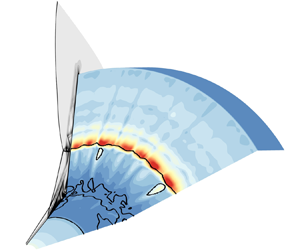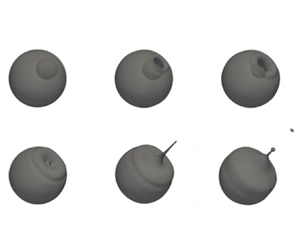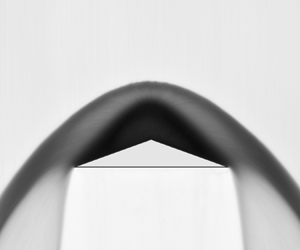Graphical abstract from Faugaret, A., Duguet, Y., Fraigneau, Y. & Martin Witkowski, L. 2022 A simple model for arbitrary pollution effects on rotating free-surface flows. J. Fluid Mech. 935, A2. doi:10.1017/jfm.2021.980.
JFM Rapids
Segregation forces in dense granular flows: closing the gap between single intruders and mixtures
-
- Published online by Cambridge University Press:
- 03 February 2022, R1
-
- Article
- Export citation
JFM Papers
Inverse cascade suppression and shear-layer formation in magnetohydrodynamic turbulence subject to a guide field and misaligned rotation
-
- Published online by Cambridge University Press:
- 25 January 2022, A1
-
- Article
- Export citation
A simple model for arbitrary pollution effects on rotating free-surface flows
-
- Published online by Cambridge University Press:
- 25 January 2022, A2
-
- Article
-
- You have access
- Open access
- HTML
- Export citation
Multiple-scales analysis of wave evolution in the presence of rigid vegetation
-
- Published online by Cambridge University Press:
- 25 January 2022, A3
-
- Article
- Export citation
Influence of slip velocity in a two-phase bubbly jet
-
- Published online by Cambridge University Press:
- 25 January 2022, A4
-
- Article
- Export citation
Wave breaking and jet formation on axisymmetric surface gravity waves
-
- Published online by Cambridge University Press:
- 25 January 2022, A5
-
- Article
- Export citation
Near-wake dynamics of a vertical-axis turbine
-
- Published online by Cambridge University Press:
- 25 January 2022, A6
-
- Article
-
- You have access
- Open access
- HTML
- Export citation
Strong alignment of prolate ellipsoids in Taylor–Couette flow
-
- Published online by Cambridge University Press:
- 25 January 2022, A7
-
- Article
-
- You have access
- Open access
- HTML
- Export citation
Three-dimensionality of hypersonic laminar flow over a double cone
-
- Published online by Cambridge University Press:
- 25 January 2022, A8
-
- Article
-
- You have access
- Open access
- HTML
- Export citation
A numerical and experimental investigation of rolling and sliding motion of rotating spheres inside a cylinder
-
- Published online by Cambridge University Press:
- 25 January 2022, A9
-
- Article
-
- You have access
- Open access
- HTML
- Export citation
A vorticity-based criterion to characterise leading edge dynamic stall onset
-
- Published online by Cambridge University Press:
- 25 January 2022, A10
-
- Article
-
- You have access
- Open access
- HTML
- Export citation
Propagation speed of turbulent fronts in pipe flow at high Reynolds numbers
-
- Published online by Cambridge University Press:
- 25 January 2022, A11
-
- Article
- Export citation
A computational study of thermally induced secondary atomization in multicomponent droplets
-
- Published online by Cambridge University Press:
- 25 January 2022, A12
-
- Article
-
- You have access
- Open access
- HTML
- Export citation
Detachment of strong shocks in confined granular flows
-
- Published online by Cambridge University Press:
- 25 January 2022, A13
-
- Article
-
- You have access
- Open access
- HTML
- Export citation
Horizontal miscible displacements through porous media: the interplay between viscous fingering and gravity segregation
-
- Published online by Cambridge University Press:
- 26 January 2022, A14
-
- Article
-
- You have access
- Open access
- HTML
- Export citation
Resolved and subgrid-scale crossing trajectory effects in Eulerian large eddy simulations of size-dependent droplet transport
-
- Published online by Cambridge University Press:
- 26 January 2022, A15
-
- Article
-
- You have access
- Open access
- HTML
- Export citation
Effect of phase change on jet atomization: a direct numerical simulation study
-
- Published online by Cambridge University Press:
- 26 January 2022, A16
-
- Article
- Export citation
Parameterization of mixing in stratified open channel flow
-
- Published online by Cambridge University Press:
- 27 January 2022, A17
-
- Article
-
- You have access
- Open access
- HTML
- Export citation
On the existence and formation of multi-scale particle streaks in turbulent channel flows
-
- Published online by Cambridge University Press:
- 26 January 2022, A18
-
- Article
- Export citation
Counter-flow orbiting of the vortex centre in turbulent thermal convection
-
- Published online by Cambridge University Press:
- 26 January 2022, A19
-
- Article
- Export citation














































































































